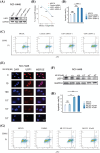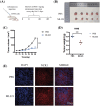Ubiquitin-specific protease 1 facilitates tumor immune escape from natural killer cells and predicts the prognosis in small cell lung cancer
- PMID: 39735674
- PMCID: PMC11671408
- DOI: 10.32604/or.2024.046895
Ubiquitin-specific protease 1 facilitates tumor immune escape from natural killer cells and predicts the prognosis in small cell lung cancer
Abstract
Objective: Small cell lung cancer (SCLC) is commonly recognized as the most fatal lung cancer type. Despite substantial advances in immune checkpoint blockade therapies for treating solid cancers, their benefits are limited to a minority of patients with SCLC. In the present study, novel indicators for predicting the outcomes and molecular targets for SCLC treatment were elucidated.
Methods: We conducted bioinformatics analysis to identify the key genes associated with tumor-infiltrating lymphocytes in SCLC. The functional role of the key gene identified in SCLC was determined both in vitro and in vivo.
Results: A significant correlation was observed between patient survival and CD56dim natural killer (NK) cell proportion. Furthermore, we noted that the hub gene ubiquitin-specific protease 1 (USP1) is closely correlated with both CD56dim NK cells and overall survival in SCLC. Bioinformatics analysis revealed that USP1 is upregulated in SCLC. In addition, gene set enrichment analysis revealed that USP1 overexpression hinders NK cell-mediated immune responses. By co-cultivating NK-92 cells with SCLC cells, we demonstrated that NK cell cytotoxicity against SCLC could be improved either via USP1 knock-down or pharmacological inhibition. Furthermore, using a nude-mice xenograft tumor model, we noted that USP1 inhibition effectively suppressed tumor proliferation and increased the expression of NK cell-associated markers.
Conclusions: Our study findings highlight the importance of NK cells in regulating SCLC. USP1 overexpression can inhibit NK cell-mediated immunity; therefore, USP1 may serve not only as a prognostic biomarker but also as a potential molecular target of SCLC therapy.
Keywords: Immune escape; Natural killer (NK) cell; Prognosis; Small cell lung cancer (SCLC); Ubiquitin-specific protease 1 (USP1).
© 2025 The Authors.
Conflict of interest statement
The authors declare no conflicts of interest to report regarding the present study.
Figures






Similar articles
-
Evasion of Innate Immunity Contributes to Small Cell Lung Cancer Progression and Metastasis.Cancer Res. 2021 Apr 1;81(7):1813-1826. doi: 10.1158/0008-5472.CAN-20-2808. Epub 2021 Jan 25. Cancer Res. 2021. PMID: 33495232 Free PMC article.
-
Combination therapy with expanded natural killer cells and atezolizumab exerts potent antitumor immunity in small cell lung cancer.Cancer Immunol Immunother. 2025 Mar 8;74(4):143. doi: 10.1007/s00262-025-03997-2. Cancer Immunol Immunother. 2025. PMID: 40056167 Free PMC article.
-
CXCR4 up-regulation mediated by USP1 deubiquitination promotes the tumorigenesis and immune escape in esophageal squamous-cell carcinoma.J Biochem Mol Toxicol. 2024 Nov;38(11):e70004. doi: 10.1002/jbt.70004. J Biochem Mol Toxicol. 2024. PMID: 39440461
-
NK cell-based therapeutics for lung cancer.Expert Opin Biol Ther. 2020 Jan;20(1):23-33. doi: 10.1080/14712598.2020.1688298. Epub 2019 Nov 12. Expert Opin Biol Ther. 2020. PMID: 31714156 Review.
-
Role of microRNAs in regulating cell proliferation, metastasis and chemoresistance and their applications as cancer biomarkers in small cell lung cancer.Biochim Biophys Acta Rev Cancer. 2021 Aug;1876(1):188552. doi: 10.1016/j.bbcan.2021.188552. Epub 2021 Apr 21. Biochim Biophys Acta Rev Cancer. 2021. PMID: 33892053 Review.
Cited by
-
Molecular regulation by ubiquitin-specific proteases (USPs) in HCC: cell cycle, oncogenic signaling, and beyond.Naunyn Schmiedebergs Arch Pharmacol. 2025 Jul 23. doi: 10.1007/s00210-025-04395-2. Online ahead of print. Naunyn Schmiedebergs Arch Pharmacol. 2025. PMID: 40699238 Review.
References
MeSH terms
Substances
LinkOut - more resources
Full Text Sources
Medical
Research Materials
Miscellaneous
